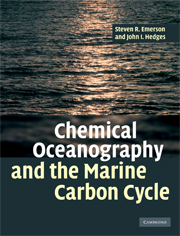Book contents
- Frontmatter
- Contents
- Preface
- Acknowledgements
- I Introduction to chemical oceanography
- 1 Oceanography background: dissolved chemicals, circulation and biology in the sea
- 2 Geochemical mass balance: dissolved chemical inflow and outflow from the ocean
- 3 Thermodynamics background
- 4 Carbonate Chemistry
- 5 Stable and radioactive isotopes
- 6 Life processes in the ocean
- 7 Paleoceanography and paleoclimatology
- II Advanced topics in marine geochemistry
- Index
- Plate section
- References
1 - Oceanography background: dissolved chemicals, circulation and biology in the sea
Published online by Cambridge University Press: 05 September 2012
- Frontmatter
- Contents
- Preface
- Acknowledgements
- I Introduction to chemical oceanography
- 1 Oceanography background: dissolved chemicals, circulation and biology in the sea
- 2 Geochemical mass balance: dissolved chemical inflow and outflow from the ocean
- 3 Thermodynamics background
- 4 Carbonate Chemistry
- 5 Stable and radioactive isotopes
- 6 Life processes in the ocean
- 7 Paleoceanography and paleoclimatology
- II Advanced topics in marine geochemistry
- Index
- Plate section
- References
Summary
A chemical perspective
This book describes a chemical perspective on the science of oceanography. The goal is to understand the mechanisms that control the distributions of chemical compounds in the sea. The “chemical perspective” uses measured chemical distributions to infer the biological, physical, chemical and geological processes in the sea. This method has enormous information potential because of the variety of chemical compounds and the diversity of their chemical behaviors and distributions. It is complicated by the requirement that one must understand something about the reactions and time scales that control the chemical distributions. Chemical concentrations in the sea “remember” the mechanisms that shape them over their oceanic lifetime. The time scales of important mechanisms range from seconds or less for very rapid photochemical reactions to more than 100 million years for the mineral-forming reactions that control relatively unreactive elements in seawater. The great range in time scales is associated with an equally large range in space scales, from chemical fluxes associated with individual organisms to global processes like river inflow and hydrothermal circulation.
Studies of chemical oceanography have evolved from those focused on discovering what is in seawater and the physical–chemical interactions among constituents to those that seek to identify the rates and mechanisms responsible for distributions. Although there is still important research that might be labeled “pure marine chemistry,” much of the field has turned to the chemical perspective described here, resulting in a fascinating array of new research frontiers.
- Type
- Chapter
- Information
- Chemical Oceanography and the Marine Carbon Cycle , pp. 3 - 32Publisher: Cambridge University PressPrint publication year: 2008
References
- 1
- Cited by



